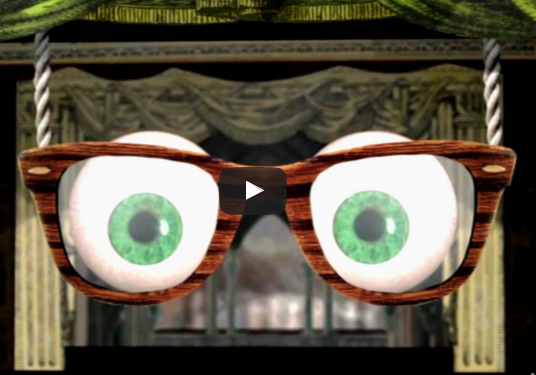(单词翻译:单击)
Optics, or the enhancement of our natural vision,
光学,或者说对我们自然视力的提升,
has been one of the biggest catalysts for science over the past 500 years,
是过去500年来科学发展的最大催化剂之一。
Interestingly, it wasn't scientific interest, but more practical matters that led to the initial advancements in optics,
有趣的是,最初光学的发展并不是出于科学兴趣,而是更实际的事物——
starting around 1440 when Johannes Gutenberg invented his printing press.
早在1440年左右,约翰尼斯·古登堡发明了印刷机。
In short order, books, which had been a rarity, were now becoming a widespread phenomenon.
很快,书籍不再是稀罕物,得到了广泛传播。
All that new reading material meant more knowledge was circulating,
新兴的阅读材料使得更多知识得以传播,
but it also meant that more people were straining their eyes, likely as they read by candlelight.
但也使得更多秉烛夜读的人们在烛光下耗费视力。
And while spectacles had been invented in Italy around 1286, the need for reading glasses increased substantially.
当1286年眼镜在意大利被发明出来,对老花镜的需求猛增。
Now that people could use lenses to see things more clearly,
因为借助眼镜能看得更清楚,
they started wondering if vision could be enhanced to see things the human eye couldn't perceive by its own devices.
人们开始探索是否能够提升视力进而看清肉眼看不清的东西。
Robert Hooke pursued microscopy, and 1665 he published his findings of worlds inside worlds,
醉心显微镜学的罗伯特·胡克于1665年将他关于微观世界的研究结果出版,
which he called 'cells' in the book 'Micrographia.'
在他的书《显微制图》里,他将微观世界里的基本构造叫作“细胞”。
At the other end of the spectrum, Galileo innovated with telescopic lenses,
在光谱的另一头,伽利略发明了望远镜。
and in 1609, he had refined a telescope until he had an instrument powerful enough to see distant objects in the sky with an accuracy no one had before him.
1609年,他改进了望远镜,使其能以前所未有的精确度探索遥远的天际。

He found that the moon had craters and mountains,
他发现了月球上的环形山
that Jupiter had moons of its own, and the whole system governing the earth and space was brought into question.
发现了木星也有卫星,开始探索支配地球和太空的整个系统。
Not everyone was thrilled with all the things Galileo saw though.
但并非所有人都为伽利略的发现惊叹。
For instance, it was taught at the time that the moon was a perfectly smooth sphere.
比如,那时候人们还认为月球是个光滑完美的圆球。
Yet here was visual proof that was awfully hard to discount.
但现在有了难以忽视的视像证据。
Upon finding moons around Jupiter, he also verified what Johannes Kepler had surmised:
发现木星的卫星后,伽利略同时验证了约翰内斯·开普勒的推测:
that the earth was not the center of the universe, dispelling another central dogma of Galileo's day.
地球不是宇宙的中心。即否定了同时期其他“地心说”学说。
Then almost exactly a year after Galileo died, Isaac Newton was born.
伽利略去世差不多一年后,艾萨克·牛顿诞生。
A lot that had been unknown was visible by now,
当年未知的世界现在已清晰可见,
but much of it was simply the foundation for further questions.
但这些大都只是未来更多问题的基础。
What was light anyway? And color, for that matter?
光是什么?颜色又是什么?
What were the laws that governed the earth, and the heavens?
支配地球和天空的规律又是怎样?
And could we capture them through keen observation?
我们是否能够通过细致的观察掌握真相?
Newton experimented extensively with optics, and came to understand light as something of substance,
牛顿对光学进行了深入研究,认识到光是某种物质,
and colors as components of light at different frequencies.
颜色是由不同频率的光组成的。
Before Newton, people widely believed that the color was due to different amounts of light,
在牛顿以前,人们普遍认为颜色是由于光的数量不同,
with red being lots of light, and blue being mostly dark.
比如红色是聚集了很多光,而蓝色则基本是不亮。
Newton's prism experiments showed that white light could not only be broken into its component colors with one prism,
牛顿的棱镜实验表明,白光经过一面三棱镜会分解出不同的光,
but that a second lens could recompose those colors back into white light again,
而多放一面三棱镜,光线又会聚合成一束白光。
thus showing that color was a matter of light's refraction rather than how light or dark it was.
这个实验说明颜色是由光的折射现象形成的,而不取决于光线数量的多少。
Newton's studies of optics led to the development of the reflecting telescope.
牛顿的光学研究促进了反射式望远镜的发展。
This, together with his study of planetary motion, led to his theory of gravitation,
牛顿的光学研究和他对行星运动的研究,共同催生了万有引力理论。
one of the world's greatest examples of learning to see something invisible by observing its effect on things that are visible.
万有引力的发现是世界上最伟大的发现之一,它通过观察无形事物对有形事物的作用来了解无形的事物。
So fast forward a few hundred years, and here we stand.
以至几百年后的今天,我们取得现在的认识。
We've evolved from a single lens to optics that reveal the birth of a star in another galaxy,
我们从一个镜片发展出光学,发现了其他星系内恒星的诞生,
or a child developing in the womb, or an electron whirling around an atom.
看到子宫中孕育的婴孩的模样,发现围绕原子旋转的电子。
At a time when so much is visible, how we see the world around us matters even more than what we see.
这么多东西都可以观察到,我们如何去观察比我们看到了什么更加重要。
Will we see a world where everything important has already been discovered?
我们是否已经发现了世上所有重要的事物?
Or will we see one in which yesterday's discoveries are but a doorway to the breakthroughs of tomorrow?
还是我们只是打开了一扇发现之门,将来还有更多未知世界等我们去探索?


